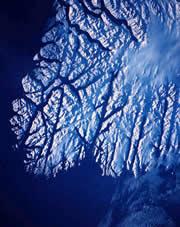 Rapid warming in Greenland's past was driven from the South Pole.Getty
Rapid warming in Greenland's past was driven from the South Pole.GettyResearchers trying to understand sudden, seesawing changes in the Arctic's prehistoric climate have found some answers in an unusual place: buried in the Antarctic ice, half a world away. Their work could help to predict the future consequences of sudden polar warming.
By digging more than 2,500 metres down into the Antarctic ice, climate scientists have shown that changes at one pole influence the other. This 'climate seesaw' moves heat from south to north along the length of the Atlantic Ocean.
Similar studies from Greenland have shown that the Arctic climate can warm by as much as 16 °C in just a few decades. The results from Antarctica confirm a theory that these warming episodes, and their subsequent cooling periods, swing back and forth between the poles.
The theory's confirmation could help climatologists to predict the effects of current and future polar warming, says team member Eric Wolff, of the British Antarctic Survey in Cambridge. "If we are sure that climate change in the past has been caused by ocean circulation, we can gauge what might happen."
Fine detail
Members of the European Project for Ice Coring in Antarctica (EPICA) extracted an ice core from Dronning Maud Land, in the Atlantic sector of Antarctica. Bubbles trapped in the ice preserve traces of the atmosphere — and therefore climate — dating back some 150,000 years.
This is not EPICA's longest record of Antarctic climate — their core from Dome C near Vostok dates back 800,000 years — but it is the most detailed. The rate of snowfall at Dronning Maud was more than double that at Dome C, meaning that the new core has much better resolution, revealing climate shifts over centuries or even decades.
As the Antarctic warms, the ocean currents that carry water away from the continent become stronger. Warm water flows as a surface current to the Arctic. Stronger currents transfer more heat to the North Pole, and cool the South. Cold water flows back southward along the ocean floor.
As the Arctic warms, its ice begins to melt. This adds fresh water to the sea, which disrupts the current, because it is less dense than salt water and therefore means that the diluted cold water sinks less readily.
With the current weakened, the Antarctic retains more of the Sun's heat. This warms the southern oceans, eventually causing the there ice to retreat and allowing water to enter the Atlantic from other oceans, thus strengthening the current again and completing the cycle.
Future trends
The EPICA team deduced the temperature record by studying the oxygen isotopes in the Antarctic core, and found that cold conditions in Greenland tend to be associated with warming in Antarctica, and vice versa. They publish their findings in this week's Nature1.
The poles are warming faster than the rest of the world - Greenland is predicted to warm by another 8 °C by the end of the century, and in recent decades the Antarctic has been warming at three times the global average rate. But it is unlikely that the Gulf Stream will shut down entirely, as in the film The Day After Tomorrow, says Wolff.
ADVERTISEMENT
During past rapid warming events, ice fields in North America probably melted, he explains. But these no longer exist, so there is less ice available to provide fresh meltwater.
Nevertheless, these prehistoric climate shifts were relatively localized, rather than the worldwide warming being caused by greenhouse gases, Wolff adds. "They were very abrupt," he says. "But they were regional, not global."
Visit our warmingseesaws_betwee.html">newsblog to read and post comments about this story.
-
References
- EPICA Community Members, . Nature, 444 . 195 - 198 (2006). | Article |
